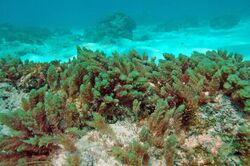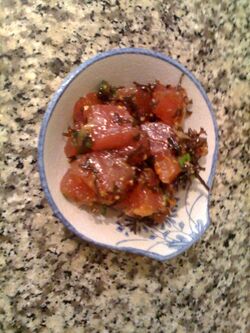Biology:Asparagopsis taxiformis
| Limukohu | |
|---|---|

| |
| Asparagopsis taxiformis in Mayotte. | |
| Scientific classification | |
| (unranked): | Archaeplastida |
| Division: | Rhodophyta |
| Class: | Florideophyceae |
| Order: | Bonnemaisoniales |
| Family: | Bonnemaisoniaceae |
| Genus: | Asparagopsis |
| Species: | A. taxiformis
|
| Binomial name | |
| Asparagopsis taxiformis (Delile) Trevis.
| |
| Synonyms | |
|
Asparagopsis sanfordiana | |
Asparagopsis taxiformis, (limu kohu) formerly A. sanfordiana,[1] is a species of red alga, with cosmopolitan distribution in tropical to warm temperate waters.[2]
Lifecycle
Like many red algae, A. taxiformis has a haplodiplophasic lifecycle, with each phase morphologically distinct. The species' haploid stage was initially described as Falkenbergia hillebrandii (Bornet) Falkenberg 1901 because it was thought to be a separate species.
Culinary uses
Asparagopsis is one of the most popular types of limu.[3] in the cuisine of Hawaii, it is principally a condiment.[4] It is known as Limu kohu in the Hawaiian language meaning "pleasing seaweed".[5] Limu kohu is a traditional ingredient in poke.
The essential oil of limu kohu is 80% bromoform (tri-bromo-methane)[6] by weight, and includes many other bromine- and iodine-containing organic compounds.[4]
Methane emissions reduction in cattle
In 2014, researchers at CSIRO and James Cook University demonstrated that feeding ruminants a diet consisting of 1-2% percent red seaweed reduced their methane emissions by over 90 percent.[7] Of 20 types of seaweed tested, A. taxiformis showed the most promise, with nearly 99 percent effectiveness.[8] The findings spurred interest from leading academic and trade organizations to further investigate its effects on ruminant animal production.[9] Some findings of research on these effects have been that the dichloromethane extract (found in A. taxiformis) was the most potent bioactive, reducing methane production by 79 %. Other bioactives found were bromoform, dibromochloromethane, bromochloroacetic acid and dibromoacetic acid.[10]
Supply from wild harvest is not expected to be adequate to support broad adoption. A. taxiformis has yet to be commercially farmed at scale. A research/development initiative called Greener Grazing is seeking to close the life cycle of A. taxiformis and demonstrate ocean based grow-out.[11] A startup out of KTH Royal Institute of Technology; Volta Greentech and Symbrosia from Yale University, are both working to grow A. taxiformis. Symbrosia is looking to integrate the cultivation with Whiteleg shrimp on land, using a patent-pending technology.[12] Sea-based cultivation has been proposed as a path to scale production and "drive the cost down so it can be used by beef and dairy farmers around the world".[13]
See also
- Limu (algae)
References
- ↑ Ní Chualáin, F.; Maggs, C.A.; Saunders, G.W.; Guiry, M.D. (2004). "The invasive genus Asparagopsis (Bonnemaisoniaceae, Rhodophyta): molecular systematics, morphology, and ecophysiology of Falkenbergia isolates". Journal of Phycology 40 (6): 1112–1126. doi:10.1111/j.1529-8817.2004.03135.x.
- ↑ ":: Algaebase". http://www.algaebase.org/search/species/detail/?species_id=636.
- ↑ Mary Kawena Pukui and Samuel Hoyt Elbert (2003). "lookup of limu kohu". in Hawaiian Dictionary. Ulukau, the Hawaiian Electronic Library, University of Hawaii Press. http://wehewehe.org/gsdl2.85/cgi-bin/hdict?a=q&j=pk&l=en&q=limu+kohu.
- ↑ 4.0 4.1 B. Jay Burreson (1976). "Volatile halogen compounds in the alga Asparagopsis taxiformis (Rhodophyta)". Journal of Agricultural and Food Chemistry 24 (4): 856–861. doi:10.1021/jf60206a040.
- ↑ Mary Kawena Pukui and Samuel Hoyt Elbert (2003). "lookup of kohu". in Hawaiian Dictionary. Ulukau, the Hawaiian Electronic Library, University of Hawaii Press. http://wehewehe.org/gsdl2.85/cgi-bin/hdict?a=q&j=pk&l=en&q=kohu.
- ↑ Burreson, B. Jay; Moore, Richard E.; Roller, Peter P. (1976). "Volatile halogen compounds in the alga Asparagopsis taxiformis (Rhodophyta)". Journal of Agricultural and Food Chemistry 24 (4): 856. doi:10.1021/jf60206a040.
- ↑ Machado, Lorenna; Magnusson, Marie; Paul, Nicholas A.; de Nys, Rocky; Tomkins, Nigel (2014-01-22). "Effects of Marine and Freshwater Macroalgae on In Vitro Total Gas and Methane Production" (in en). PLoS ONE 9 (1): e85289. doi:10.1371/journal.pone.0085289. ISSN 1932-6203. PMID 24465524.
- ↑ "Seaweed could hold the key to cutting methane emissions from cow burps - CSIROscope" (in en-US). CSIROscope. 2016-10-14. https://blog.csiro.au/seaweed-hold-key-cutting-methane-emissions-cow-burps/.
- ↑ "Can Seaweed Cut Methane Emissions on Dairy Farms?" (in en). 2018-05-24. https://www.ucdavis.edu/news/can-seaweed-cut-methane-emissions-dairy-farms/.
- ↑ Identification of bioactives from the red seaweed Asparagopsis taxiformis that promote antimethanogenic activity in vitro
- ↑ "Gassy cows are bad for the planet; could seaweed diet help?" (in en-US). AP News. https://apnews.com/31b0a326b3614135a270d9fc2dfcfe7d.
- ↑ "Symbrosia" (in en-US). https://www.symbrosiasolutions.com/.
- ↑ Boys, Callan (15 February 2020). "The fish farmer growing seaweed to feed cows and save the planet". Good Food. https://www.goodfood.com.au/eat-out/news/the-fish-farmer-growing-seaweed-to-feed-cows-and-save-the-planet-20200214-h1lt88.
External links
Guiry, M.D.; Guiry, G.M., "'Asparagopsis taxiformis'", AlgaeBase (World-wide electronic publication, National University of Ireland, Galway), https://www.algaebase.org/search/species/detail/?species_id=636&- Wikidata ☰ Q4807687 entry
 |


